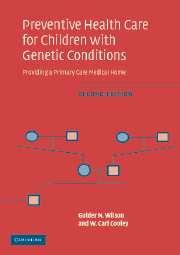Book contents
- Frontmatter
- Contents
- Preface
- Glossary of genetic and molecular terms
- Part I Approach to the child with special needs
- Part II The management of selected single congenital anomalies and associations
- 4 Congenital anomalies associated with developmental disability
- 5 Single anomalies, sequences, and associations
- 6 Teratogenic syndromes
- Part III Chromosomal syndromes
- Part IV Syndromes remarkable for altered growth
- Part V Management of craniofacial syndromes
- Part VI Management of connective tissue and integumentary syndromes
- Part VII The management of neurologic and neurodegenerative syndromes
- Part VIII Management of neurodegenerative metabolic disorders
- References
- Index
6 - Teratogenic syndromes
Published online by Cambridge University Press: 29 January 2010
- Frontmatter
- Contents
- Preface
- Glossary of genetic and molecular terms
- Part I Approach to the child with special needs
- Part II The management of selected single congenital anomalies and associations
- 4 Congenital anomalies associated with developmental disability
- 5 Single anomalies, sequences, and associations
- 6 Teratogenic syndromes
- Part III Chromosomal syndromes
- Part IV Syndromes remarkable for altered growth
- Part V Management of craniofacial syndromes
- Part VI Management of connective tissue and integumentary syndromes
- Part VII The management of neurologic and neurodegenerative syndromes
- Part VIII Management of neurodegenerative metabolic disorders
- References
- Index
Summary
It is quite remarkable that only about 20 of the more than 50,000 drugs and chemicals in common use are proven human teratogens (Jones, 1997, pp. 555–79; Schardein, 2000; Gorlin et al., 2001, pp.14–34). Considerably more – about 180 of 2800 tested – are teratogenic in two or more animal species (Schardein, 2000). The example of Dr. Lenz, the pediatrician who identified thalidomide babies in 1961, emphasizes the need for physicians to be alert and knowledgeable about potential teratogens. The reference of Schardein (2000) and telephone hotlines and websites offer guides to specific teratogens, including ReproTox (www.reprotox.org); TERIS plus Shephard's Catalogue of Teratogenic Agents (http:/ /depts.washington.edu/ ∼terisweb/index.html), International Toxicity Estimates for Risk Database (www. tera.org/iter/), and parent-oriented literature from the Organization of Teratology Information Services (www.otispregnancy.org). Although teratology is a general term for the study of developmental anomalies, it is used here in the more limited sense to describe anomalies caused by environmental agents (physical, chemical, or infectious).
Parents are frequently concerned about environmental exposures to substances such as pesticides or industrial agents when their child has a congenital anomaly. It is again reassuring that only one environmental chemical, methyl mercury, is a proven human teratogen. The many lawsuits concerning agents such as dioxin or Bendectin are truly an American tragedy (Brent, 2004). These unscrupulous awards provide sad testimony to our inadequate science of congenital anomalies. Brent (2004) has reviewed the criteria required to prove that an agent is a human teratogen.
- Type
- Chapter
- Information
- Preventive Health Care for Children with Genetic ConditionsProviding a Primary Care Medical Home, pp. 116 - 148Publisher: Cambridge University PressPrint publication year: 2006



